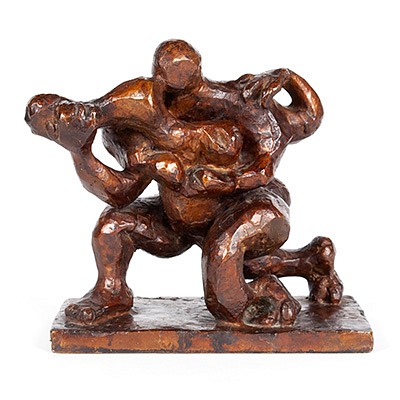SAM GILLIAM (AMERICAN, 1933-2022)
About Seller
555 Washington Ave, Ste 129
St. Louis, MO 63101
United States
Two ways to bid:
- Leave a max absentee bid and the platform will bid on your behalf up to your maximum bid during the live auction.
- Bid live during the auction and your bids will be submitted real-time to the auctioneer.
Bid Increments
| Price | Bid Increment |
|---|---|
| $0 | $5 |
| $30 | $10 |
| $100 | $25 |
| $500 | $50 |
| $1,000 | $100 |
| $3,000 | $250 |
| $5,000 | $500 |
| $10,000 | $1,000 |
| $30,000 | $2,500 |
| $50,000 | $5,000 |
| $100,000 | $10,000 |
| $300,000 | $25,000 |
| $500,000 | $50,000 |
About Auction
Jul 15, 2023
Period furniture and art entangle dramatically with modern and contemporary works. Selkirk Auctioneers & Appraisers info@selkirkauctions.com
- Lot Description
Sam Gilliam
American, 1933-2022
Doc IV, 1979
Oil on two molded canvases, signed, titled, and dated to verso
In diptych: sage, mauve, rust, and azure tones bleed onto a pale field in two trapezoidal, asymmetrical parts. Middendorf/Lane Gallery, Washington D.C. gallery label to verso.
Sam Gilliam was born on November 30, 1933 in Tupelo, Mississippi. He moved with his family to Kentucky as a child, and he graduated from the University of Louisville with his bachelor’s degree in 1955. Already a promising artist, he had his first solo exhibition that year at the University. Gilliam went on to receive his MFA from the University of Louisville in 1961.
Gilliam established himself at the forefront of American abstraction while working in Washington, D.C. in the 1960s, when his experiments with paint application and his radical transformation of the canvas support profoundly expanded the possibilities for the future of abstract painting. Working alongside Color Field painters such as Kenneth Noland and Thomas Downing, Gilliam elaborated upon Color Field processes and aesthetics while subverting Greenbergian notions of the “integrity of the picture plane,” and disrupting the boundaries between the visual world of painting and the tangible world outside it. At a time during the Civil Rights movement, when African American artists were expected by many to create figurative work explicitly addressing racial subject matter, Gilliam persisted in pursuing the development of a new formal language that celebrated the cultivation and expression of the individual voice and the power of non-objective art to transcend cultural and political boundaries.
The late 1960s proved a fertile period for innovation, with Gilliam transforming the canvas support through two critical interventions. In 1967 Gilliam created his first “Beveled-Edge”, or “Slice”, paintings: canvases with luminous colors on custom-made stretchers with a beveled edge which project toward the viewer, removing the painting from the wall.
Gilliam was prominently featured at the Central Pavilion of the 57th Venice Biennale in 2017, where he was also featured in 1972 at the 36th Venice Biennale’s American Pavilion curated by Walter Hopps. In 2015 he had the prestigious honor of receiving the United States Department of State’s first ever Medal of Arts Lifetime Achievement Award. His work is represented in public collections worldwide, including the Metropolitan Museum of Art, New York; the Museum of Modern Art, New York; the Whitney Museum of American Art, New York; and the Tate, London, among others.
Sam Gilliam passed away at the age of 88.
40 x 22 in. (101.6 x 55.9 cm.) & 38 x 18 1/2 in. (96.5 x 47 cm.)
The Artist;
Middendorf/Lane Gallery, Washington D.C.;
Ex Iowa Wesleyan University collection;
Bequeathed by the Alden Lowell Doud Estate, Washington D.C.
Alden Lowell Doud (American, 1935-1912) of Iowa City, formerly of Douds, was a former First Lieutenant and Captain of the U.S. Army Judge Advocate General Corp. After serving in the military, he joined the Office of the Legal Adviser in the U.S. State Department in 1967 where he became the first Assistant Legal Adviser for Environmental Affairs. He authored the first drafts of several important environmental treaties including the World Heritage Convention. He was also a member of the U.S. delegation in the negotiations forming the International Telecommunications Satellite Consortium (INTELSAT).
In 1973, Mr. Doud joined the World Bank Legal Department as its principal administrative attorney and rose to the title of Chief Counsel until his retirement in 1996. Post retirement,
he studied at the Courtlaud Institute of Art in London and continued art studies at Bard Graduate Center in New York City.
He moved to Iowa City in 1998 and served as Chairman of Board of Trustees of Iowa Wesleyan until 2005 when he received an honorary degree Ll. D. and was made Chairman Emeritus. He was a member of University of Iowa President's Club, the Members Council of the University Museum of Art, the Harvard Club of New York City, and other arts related organizations.Condition
Any condition statement is given as a courtesy to a client, is an opinion, and should not be treated as a statement of fact. Reference to condition written, oral or within a condition report shall not be regarded as a full account of condition and may not include all defects, alterations, or restorations. Absence of a condition report does not imply a lot is flawless or lacking imperfections or damage. Selkirk Auctioneers & Appraisers shall have no responsibility for any error or omission. Returns shall not be accepted on the basis of condition.
- Shipping Info
-
The buyer is responsible for arranging pick-up and shipment of all purchased lots. All registered bidders are responsible for obtaining quotes through in-house shipping or a third-party shipping agent, in advance of bidding. A list of third-party shippers is made available on Selkirk’s website, as well as at the time of invoicing. Not all items are eligible for in-house shipping. Selkirk will not be responsible for any loss, damage, theft, or otherwise responsible for any items left in Selkirk’s possession ten (10) days after the sale. If arrangements for shipping have not been made and communicated within thirty (30) days, Selkirk reserves the right, at this time, to charge a storage fee of $10 per lot per day for furniture and large format items and $5 per lot per day for all other items, and within sixty (60) days, at its own discretion, sell any items left on the premises. Accumulated fees resulting from storage and insurance cost will be taken out of any proceeds. Objects that contain materials of endangered or protected species may be subject to regulations disallowing export and import into other states or countries. It is the buyer’s responsibility to be aware of all applicable laws and regulations and to obtain any required export or import licenses or certificates and any other required documentation. Disputes arising from damage incurred during in-house shipping are subject to the terms and conditions of filing a shipping insurance claim and of no guarantee.
-
- Buyer's Premium



 EUR
EUR CAD
CAD AUD
AUD GBP
GBP MXN
MXN HKD
HKD CNY
CNY MYR
MYR SEK
SEK SGD
SGD CHF
CHF THB
THB

































